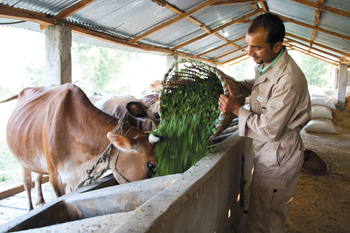Artificial insemination has helped villagers in Kaski to improve the breed and increase productivity of their livestock

CINDREY LIU
FEEDING TIME: Narayan Bhandari from Bharat Pokhari, Kaski, is happy working hard in his own territory.
After toiling in Saudi Arabia for seven years, Narayan Bhandari (pic, right) returned home in 2011 determined to earn a living in his own country.
He planned to invest the money he had saved up to upgrade his family farm in Bharat Pokhari, but soon realised it wasn’t viable. He then heard about ‘artificial insemination’ (AI) that farmers in his village claimed helped improve the breed and increase productivity of their livestock. The 33-year-old took the risk and adopted AI in the Sunrise Multi-Agrofarm that he set up.
By using sperms from high breed bulls, farmers can produce superior quality calves and vastly improve production traits. Crossbred calves give almost twice as much milk as their mothers. At Bhandari’s farm, a mother cow produces six litres of milk per day, while her calves produce up to ten.
Artificial insemination also removes the risk of injuries and transfer of diseases from male to female animals and helps farmers cut costs on rearing bulls. Usually one herd bull is enough for a medium-size farm and farmers like Bhandari, who owns 22 cows and no bulls, are also sharing one male among themselves.
“Nepal has 13 million cattle and buffaloes, but only two million produce at an average of two litres per day, while artificially inseminated breeds can produce 20 litres,” says Bimal Kumar Nirmal at the National Livestock Breeding Centre (NLBC).
Currently, 51.5 kg of milk is available per capita per year in Nepal, which is far below the WHO recommended 91.25 kg. The Jersey and Holestein cattle breeds and the Murrah buffaloes are preferred because they are more suitable for the country’s climate. Although artificial insemination was first introduced in Nepal 50 years ago, it was only practiced on five per cent of all cattle and buffaloes.
“We were just not producing enough quality semen and farmers did not have faith in our products,” explains Nirmal.
In an effort to boost milk production and raise the income of dairy farmers, the government started the Promotion of Livestock Breeding Improvement project in 2011 with an initial budget of Rs 100 million. NLBC was given the responsibility of producing and distributing semen throughout the country.
Within a year, Nirmal and his team were able to quadruple semen production to 400,000 doses, most of which was then distributed to 58 districts across Nepal. In the past 12 months, more than 130,000 artificially inseminated calves have been born and the total coverage has reached 15 per cent. Dairies in Kathmandu, Pokhara, and Chitwan that used to import 200,000 litres of milk from India every morning are now using locally produced milk.
The project wouldn’t have been a success, however, without the active participation of local communities. The 250 Community Livestock Breeding Centres across the country which help in the distribution of semen and supervision of inseminators are completely run by farmers.
Satish Lamichhane, 31, from Lekhnath of Kaski started working as an inseminator three years ago after being trained by NLBC. On average, he performs four inseminations a day and is paid up to Rs 500 each time. There are currently 600 inseminators at 500 centres (both government and private) spread across the country and NLBC provides them with necessary equipment free of cost.
Says Bhandari: “My dairy farm is doing well, I will never go back to Saudi Arabia again.”
Dairy diary
After tests carried out by the
Food Technology and Quality Control Departmentearlier this month found dangerous levels of coliform bacteria in milk supplied by at least six dairies in the Valley, demand saw a sharp decline and dairy farmers found themselves in a tight spot.
What is considered a ‘safe’ level of coliform varies from country to country: zero per cent in the US, five per cent in the EU, and ten per cent in India and Pakistan. Dairy experts agree that demanding milk producers in Nepal to maintain zero per cent bacteria is not feasible and will only harm poor farmers.
“Maintaining hygiene is a long process that should start in the cow shed and be followed all the way to the consumer’s kitchen,” explains Heramba Rajbhandary, owner of the private Nepal Dairy. “We could train farmers but there is shortage of clean water in many parts of the country. We could introduce stricter measures at the chilling plant, but there is 8-10 hours of load shedding. The problems within the dairy industry are indicative of larger problems in the country.”
He says Nepal just doesn’t have the technology at the moment where we can replicate the level of hygiene that is practiced in the US. While regular state monitoring and harsher laws will help keep dairy owners in check, there is also a need to improve infrastructure in the villages and towns from where most of Nepal’s milk is collected.
Training farmers in hygiene methods in a country where cow urine and dung are still considered holy is also essential. Until then, the onus to remain safe will be on the consumers.
Trishna Rana
Read also:
Earning from nature to pay for its upkeep